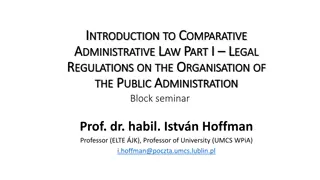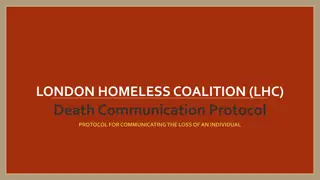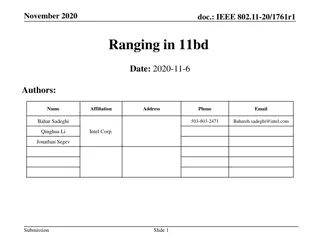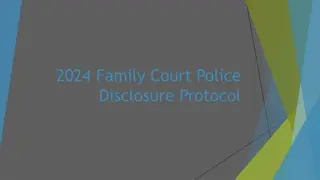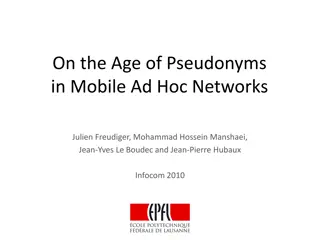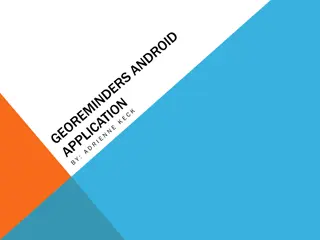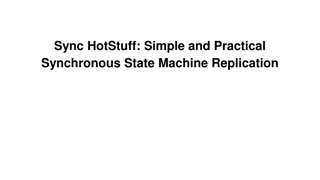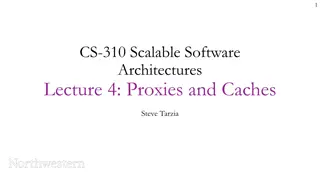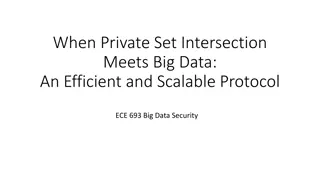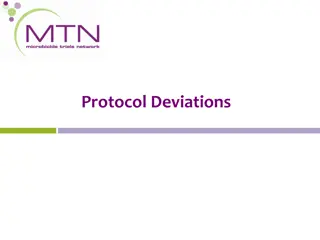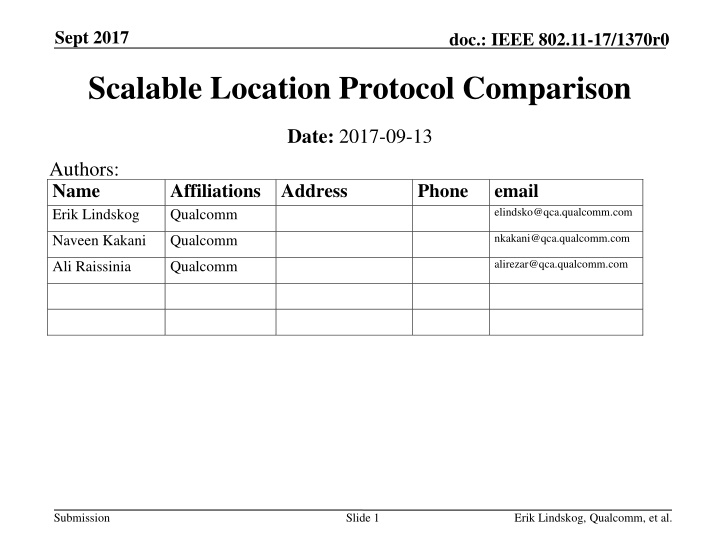
Comparison of Scalable Location Protocols in IEEE 802.11-17
"This presentation compares and contrasts Scalable Location Protocols in IEEE 802.11-17, focusing on DTOA and CToA styles, with practical protocol realizations discussed. Examples and protocols for fixed Wi-Fi devices and client-centric scenarios are illustrated."
Download Presentation

Please find below an Image/Link to download the presentation.
The content on the website is provided AS IS for your information and personal use only. It may not be sold, licensed, or shared on other websites without obtaining consent from the author. If you encounter any issues during the download, it is possible that the publisher has removed the file from their server.
You are allowed to download the files provided on this website for personal or commercial use, subject to the condition that they are used lawfully. All files are the property of their respective owners.
The content on the website is provided AS IS for your information and personal use only. It may not be sold, licensed, or shared on other websites without obtaining consent from the author.
E N D
Presentation Transcript
Sept 2017 doc.: IEEE 802.11-17/1370r0 Scalable Location Protocol Comparison Date: 2017-09-13 Authors: Name Erik Lindskog Affiliations Address Qualcomm Phone email elindsko@qca.qualcomm.com nkakani@qca.qualcomm.com Naveen Kakani Qualcomm alirezar@qca.qualcomm.com Ali Raissinia Qualcomm Submission Slide 1 Erik Lindskog, Qualcomm, et al.
Sept 2017 doc.: IEEE 802.11-17/1370r0 Summary In this presentation we are comparing and contrasting DTOA style and CToA style scalable location as well as outlining a practical realization of a protocol for DToA style scalable location. . Submission Slide 2 Erik Lindskog, Qualcomm, et al.
Sept 2017 doc.: IEEE 802.11-17/1370r0 CToA Scalable Location Protocol Submission Slide 3 Erik Lindskog, Qualcomm, et al.
doc.: IEEE 802.11-17/1370r0 Illustration of CToA Protocol [5,6] frequency bSTA#2 bSTA#2 <<1ms bSTA#3 bSTA#3 Legend: AP non-availability window on nativechannel bSTA#4 bSTA#4 NativeAP channel CToA RX + AP RX CToA Beacon broadcast by bSTA#1 CToA Beacon broadcast by bSTA#2 Channel arbitration bSTA#1 bSTA#1 <<1ms 2 bSTAs broadcast time 802.11az NDPA (ToD-only) SIFS NDP time Submission Slide 4
Sept 2017 doc.: IEEE 802.11-17/1370r0 Details of Example Protocol for DToA Style Scalable Location See also [3 and 4] Submission Slide 5 Erik Lindskog, Qualcomm, et al.
Sept 2017 doc.: IEEE 802.11-17/1370r0 Fixed Wi-Fi Devices Any venue is likely to contain a large number of fixed Wi-Fi devices. We can use these devices to facilitate scalable location. Submission Slide 6 Erik Lindskog, Qualcomm, et al.
Sept 2017 doc.: IEEE 802.11-17/1370r0 Client Centric Scalable Location Example Scenario Anchor Client Anchor Client Client to be located Access Point Access Point Anchor Client Submission Slide 7 Erik Lindskog, Qualcomm, et al.
Sept 2017 doc.: IEEE 802.11-17/1370r0 Example Frame Exchange Protocol Submission Slide 8 Erik Lindskog, Qualcomm, et al.
Sept 2017 doc.: IEEE 802.11-17/1370r0 Reuse Ranging Protocol Reuse ranging protocol Can use SU or MU ranging MU ranging has the inherit benefit of being scheduled Facilitates clients listening to transmissions No need to add new protocol for the scheduling of the ranging Submission Slide 9 Erik Lindskog, Qualcomm, et al.
Sept 2017 doc.: IEEE 802.11-17/1370r0 TGaz SFD UL MU Ranging Sounding Submission Slide 10 Erik Lindskog, Qualcomm, et al.
Sept 2017 doc.: IEEE 802.11-17/1370r0 MU ranging with Extra Frame Exchanges Green arrows Regular ranging frame exchanges Trigger Frame Trigger Frame Trigger Frame NDPA NDP AP Station NDP Anchor Client Anchor Client NDP Anchor Client NDP Note: No new transmissions or protocol required. It is simply up the anchor stations to listen to the NDP transmissions, calculate their TOA and report them. Blue arrows Extra ranging exchanges Submission Slide 11 Erik Lindskog, Qualcomm, et al.
Sept 2017 doc.: IEEE 802.11-17/1370r0 MU Ranging Operation Green arrows - Already planned exchanges in a single MU ranging operation Anchor Client Anchor Client AP Blue arrows More possible exchanges in a single MU ranging operation Anchor Client In one shot we can communicate with all other STAs! Submission Slide 12 Erik Lindskog, Qualcomm, et al.
Sept 2017 doc.: IEEE 802.11-17/1370r0 Example Protocol with MU Ranging Anchor Client 2 Anchor Client 1 Access point iFTM request Negotiation and assignment to periodic measurement interval iFTM (response) MU Poll MU Poll Response MU Poll Response Trigger Frame Unencrypted measurement in periodic measurement interval UL NDP UL NDP DL NDPA DL NDP Unencrypted measurement feedback AP Meas. Feedback AS Meas. Feedback Unencrypted reverse measurement feedback - Proposed optional AS Meas. Feedback Submission Slide 13 Erik Lindskog, Qualcomm, et al.
Sept 2017 doc.: IEEE 802.11-17/1370r0 Client Listening Submission Slide 14 Erik Lindskog, Qualcomm, et al.
Sept 2017 doc.: IEEE 802.11-17/1370r0 Client Listening Client listens to ranging exchanges AP announcement of the ranging schedule: Clients to be located knows when listening Enables clients to power save Submission Slide 15 Erik Lindskog, Qualcomm, et al.
Sept 2017 doc.: IEEE 802.11-17/1370r0 Ranging Schedule Submission Slide 16 Erik Lindskog, Qualcomm, et al.
Sept 2017 doc.: IEEE 802.11-17/1370r0 Schedule Content Recap from [3]: Two levels of schedule complexity: AP conveys scalable ranging operations in its own channel AP conveys scalable ranging operations also for neighboring APs channels Content: Times of ranging Ranging format parameters (e.g. number of antennas) Anchor Clients LCI information Additional content for neighboring APs operations: BSS channels and bandwidths Clock mappings Submission Slide 17 Erik Lindskog, Qualcomm, et al.
Sept 2017 doc.: IEEE 802.11-17/1370r0 Schedule Conveying For example: Periodically broadcast in an APs beacons Counter in every beacon to count down to presence schedule Submission Slide 18 Erik Lindskog, Qualcomm, et al.
Sept 2017 doc.: IEEE 802.11-17/1370r0 AP-AP and AP-Client Anchor Station Use Cases Submission Slide 19 Erik Lindskog, Qualcomm, et al.
Sept 2017 doc.: IEEE 802.11-17/1370r0 AP AP Use Case AP AP AP STA with known location AP CL AP AP Client STA Submission Slide 20 Erik Lindskog, Qualcomm, et al.
Sept 2017 doc.: IEEE 802.11-17/1370r0 AP Client AS Use Case CL AS CL AS Client STA with known location AP No channel hopping needed! CL CL AS CL AS Client STA Submission Slide 21 Erik Lindskog, Qualcomm, et al.
Sept 2017 doc.: IEEE 802.11-17/1370r0 Protocol to Add Submission Slide 22 Erik Lindskog, Qualcomm, et al.
Sept 2017 doc.: IEEE 802.11-17/1370r0 Protocol Aspects to Add Bit in iFTM request indicating desire for unencrypted ranging and is willingness to share LCI Protocol for periodic announcement of scalable location ranging schedule Optional: Bit in iFTM request indicating desire for double sided ranging measurement feedback And the extra frames for the reverse ranging measurement feedback This double sided feedback also have uses other than for scalable location ToA feedback from extra listening opportunities in MU ranging Only limited additions needed! Submission Slide 23 Erik Lindskog, Qualcomm, et al.
Sept 2017 doc.: IEEE 802.11-17/1370r0 Comparing and Contrasting DToA and CToA Style Protocols Submission Slide 24 Erik Lindskog, Qualcomm, et al.
Sept 2017 doc.: IEEE 802.11-17/1370r0 Commonalities Submission Slide 25 Erik Lindskog, Qualcomm, et al.
Sept 2017 doc.: IEEE 802.11-17/1370r0 DToA and CToA Scalable Location Commonalities Anchor Station(s) Anchor Station Anchor Station Client STA E.g. MU ranging UL SU/MU NDP Some form of coordination or scheduling needed to bring together transmitters and receivers Listens Listens Client and Network Centric Part DL NDP Listens Listens Operation Ranging NDPs at a minimum Some form of coordination or scheduling needed to bring together transmitters and receivers Network Centric Part In CToA the Operation is a broadcast TOD/TOA measurement frame. In DToA it is a ranging measurement operation. Submission Slide 26 Erik Lindskog, Qualcomm, et al.
Sept 2017 doc.: IEEE 802.11-17/1370r0 Performance Submission Slide 27 Erik Lindskog, Qualcomm, et al.
Sept 2017 doc.: IEEE 802.11-17/1370r0 DToA vs CToA DToA and CToA protocols does not necessarily differ in how the client location is calculated. DToA style protocol can use CToA style location calculations With a DToA style protocol you can always get the same performance as with the CToA style protocol! Submission Slide 28 Erik Lindskog, Qualcomm, et al.
Sept 2017 doc.: IEEE 802.11-17/1370r0 Contrasting Submission Slide 29 Erik Lindskog, Qualcomm, et al.
Sept 2017 doc.: IEEE 802.11-17/1370r0 High Level Differences DToA RTT ranging between anchor stations. Scheduled approach CToA Broadcast TOD/TOA operation between anchor stations. Unscheduled approach Submission Slide 30 Erik Lindskog, Qualcomm, et al.
Sept 2017 doc.: IEEE 802.11-17/1370r0 Ranging measurement operation Pros Reuses existing protocol Same channel and bandwidth for packets Relaxes calibration requirements for client Compressed measurement period Relaxes the requirement for clock tracking. Periodicity of the ranging measurements can be tailored to location rather than clock tracking needs. Client stations don t need to change channel Anchor stations respond on the same channel Enables low complexity DTOA locationing Also enables CToA style Kalman filter clock tracking Submission Slide 31 Erik Lindskog, Qualcomm, et al.
Sept 2017 doc.: IEEE 802.11-17/1370r0 Ranging measurement operation Con Possibly a little higher processing requirements on the clients that may get more ranging measurements to process in a shorter period of time Counter argument: Every client don t need to process every ranging measurement Submission Slide 32 Erik Lindskog, Qualcomm, et al.
Sept 2017 doc.: IEEE 802.11-17/1370r0 Broadcast TOD/TOA operation Pros Asynchronous unscheduled operation Removes requirement to schedule operations Counter argument: This unscheduled asynchronous behavior also makes it more difficult for client stations to power save Submission Slide 33 Erik Lindskog, Qualcomm, et al.
Sept 2017 doc.: IEEE 802.11-17/1370r0 Broadcast TOD/TOA operation Cons Unscheduled asynchronous operations Makes power save for clients more difficult Dispersed operations requiring Kalman tracking of clocks. Many parameters to estimate => Large matrices to invert Periodicity of the operations need to be tailored to the clock drifts rather than location needs. Paired transmissions does not necessarily occur on the same channel and bandwidth => Increases calibration requirement on clients Operations cannot be used for lower complexity DTOA location calculations. Slide 34 Submission Erik Lindskog, Qualcomm, et al.
Sept 2017 doc.: IEEE 802.11-17/1370r0 Concluding Thoughts Submission Slide 35 Erik Lindskog, Qualcomm, et al.
Sept 2017 doc.: IEEE 802.11-17/1370r0 Concluding Thoughts Any venue is likely to contain a large number of fixed Wi-Fi clients Can use such Anchor Clients to enable scalable location - in additions to APs. Regular ranging protocol to provides time-stamped transmissions to use for scalable client location Minimal additions required to protocol for regular ranging DToA style scalable location is well suited for this and has many advantages Submission Slide 36 Erik Lindskog, Qualcomm, et al.
Sept 2017 doc.: IEEE 802.11-17/1370r0 References [1] Client Positioning using Timing Measurements between Access Points , Erik Lindskog, Naveen Kakani, Raja Banerjea, Jim Lansford and Jon Rosdahl, IEEE 802.11-13/0072r1. [2] A Low Overhead Receive Only Wi-Fi Based Location Mechanism , Erik Lindskog, Hong Wan, Raja Banerjea, Naveen Kakani and Dave Huntingford, Proceedings of the 27th International Technical Meeting of The Satellite Division of the Institute of Navigation (ION GNSS+ 2014), Tampa, Florida, September 2014, pp. 1661-1668. [3] Passive Location , Erik Lindskog, Naveen Kakani and Ali Raissinia, IEEE 802.11- 17/0417r0. [4] Scalable Location Protocol , Erik Lindskog, Naveen Kakani and Ali Raissinia, IEEE 802.11-17/0417r0. [5] High-Accuracy Indoor Geolocation using Collaborative Time of Arrival (CToA) - Whitepaper , Leor Banin, Ofer Bar Shalom, Nir Dvorecki, Yuval Amizur, IEEE 802.11- 17/1387r0. [6] Collaborative Time of Arrival (CToA) , Ofer Bar Shalom, Yuval Amizur, Leor Bani, IEEE 802.11-17/1308r0. Submission Slide 37 Erik Lindskog, Qualcomm, et al.
Sept 2017 doc.: IEEE 802.11-17/1370r0 Thank You! Submission Slide 38 Erik Lindskog, Qualcomm, et al.


